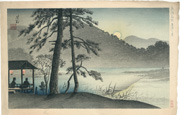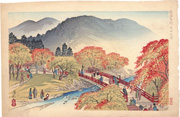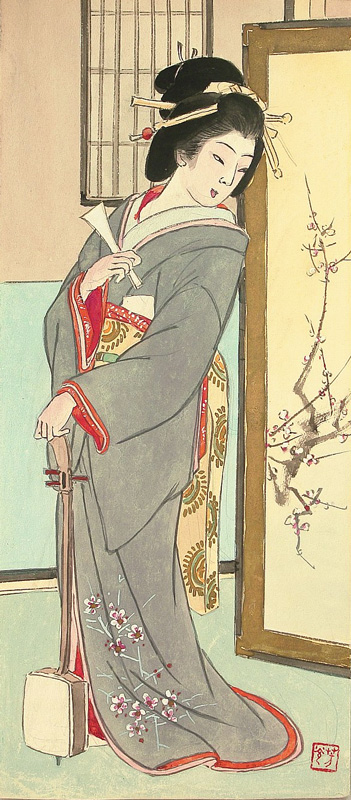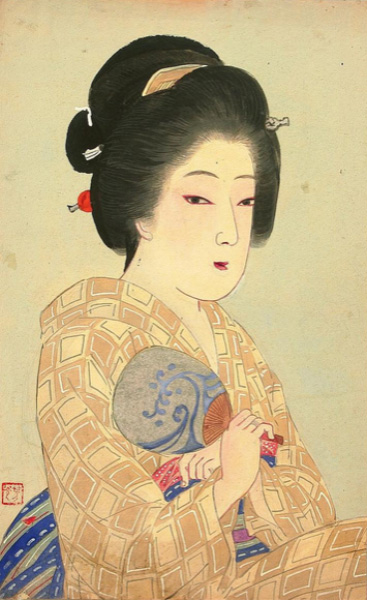Sources: Modern Japanese Prints, Dorothy Blair, The Toledo Art Museum 1997 (Printed from a photographic reproduction of two exhibition catalogues of modern Japanese prints published by The Toledo Museum of Art in 1930 and 1936); Modern Japanese Woodblock Prints - The Early Years, Helen Merritt, University of Hawaii Press, 1998, p. 87-88 and as footnoted.
Born in Osaka, Nomura Yoshimitsu was a fourth generation ukiyo-e painter of the Utagawa School. His father and first teacher was Nomura Yoshikuni 野村芳国 (Yoshikuni III; 1855-1903), a direct descendant of Utagawa Yoshikuni I, a student of Utagawa Kuniyoshi 歌川 国芳 (1797-1861). While still a teenager, Yoshimitsu exhibited sufficient talent to establish his own school.1 In 1891, at the age of 21, he began studying Western and panoramic painting in Kyoto under the French painter and etcher George Bigot (1860-1927). Nomura was to paint over thirty panoramic pictures, two of which, one of the Satsuma Rebellion and the other, in 1895, of the Japanese attack on Port Arthur, were to bring him fame. The Port Arthur battle scene was exhibited at the Fourth Industrial Exhibition held in Kyoto in 1895 and later exhibited at the Panorama Hall [Nisshin-no yaku kōkai sensō], in Tokyo’s Ueno Park2. The English language Japan Weekly Mail was to note: “The Port Arthur Panorama at Uyeno Park, Tokyo was courteously thrown open to the representatives of the foreign press on Wednesday afternoon. The painting was carried out by Nomura Yoshikuni and Nomura Yoshimitsu, of Kyoto, old pupils of Mr. Bigot, and is a spirited performance.”3
Starting in about 1915 and continually until at least 1936, Nomura designed the scenery for Kyoto’s annual Miyako Odori dance festival, using his expertise in both ukiyo-e painting and panoramic landscape.
The Artist's Prints
Yoshimitsu was primarily a painter who designed a limited number of prints4, the most famous of which are a 1931 series of six landscape prints published under the title “Kyōraku Meishō” 京洛名所 (Famous Places of Kyoto) by the Kyoto publisher Shōtarō Satō.5 Exhibited at the 1936 Toledo Exhibition, the prints were described in the catalog as skillfully harmonizing “the style of Ukiyoe painting and the method of European panoramic sceneries…”
For images of the six prints in the series see this collection's print Autumn Scenery at Takao from the series Famous Places of Kyoto.
Watercolor Paintings by the Artist
The Artelino archive displays eight watercolors of the artists, most depicting bijin (beautiful women), two of which are shown below.
Sample Signatures and Seals of the Artist
Yoshimitsu
Yoshimitsu
sankō kai
sankō kai
sankō kai in
sankō kai
sankō kai
1 I have not been able to find any information on Nomura's school.
2 The first panoramas in Japan were built in 1890 in Ueno and Asakusa parks in Tokyo, both featuring war scenes. During the Sino-Japanese War, these panoramas were changed to scenes of Port Arthur and Pyongyang. Panoramas were one of the most prominent ways in which the Japanese public became exposed to Western techniques of oil painting. [Source: Rearranging the Landscape of the Gods : The Politics of a Pilgrimage Site in Japan, 1573-1912, Sarah Thal, University of Chicago Press, 2005, p. 364
(footnote 5 for chapter 12).
3 The Japan Weekly Mail Aug 15, 1896 No. 7 Vol XXVI
4 While Merritt in Guide to Modern Japanese Woodblock Prints, p. 112 states that Nomura is “reported to have designed actor prints", I have not located any other references to these prints or images of them.
5 Shōtarō also published prints of the artists Miki Suizan (1887-1957) and Yoshikawa Kanpō (1894-1979).










